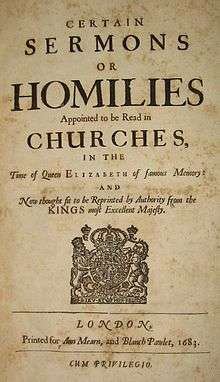The Books of Homilies
| Part of a series on |
| Anglicanism |
|---|
| Theology |
| Ministry and worship |
| Christianity |
| Background and history |
| Anglican Communion |
| Continuing Anglicanism |
|
|
The Books of Homilies (1547, 1562, and 1571) are two books of thirty-three sermons developing the reformed doctrines of the Church of England in greater depth and detail than in the Thirty-Nine Articles of Religion. The title of the collection is Certain Sermons or Homilies Appointed to Be Read in Churches.
Overview

During the reign of Edward VI and later during the reign of Elizabeth I, Thomas Cranmer and other English reformers saw the need for local congregations to be taught Christian theology and practice. Before the English Reformation, the liturgy was conducted entirely in Latin, to which the common people listened passively except twice a year during Communion, when only the consecrated bread was administered. Since parsons, vicars and curates often lacked the education and experience needed to write sermons and were often unfamiliar with Reformed doctrine, scholars and bishops wrote out a collection of sermons for them, which were appointed to be read each Sunday and holy day. The reading of the homilies in church is still mandated under Article XXXV of the Thirty-Nine Articles.
Many of the sermons are straightforward exhortations to read scripture daily and lead a life of prayer and faith in Jesus Christ; the other works are lengthy scholarly treatises intended to inform church leaders in theology, church history, the fall of the Byzantine Empire and the heresies of the Roman Catholic Church. Each homily is heavily annotated with references to holy scripture, the Church Fathers and other primary sources.
The longest homily is the second of the second book, "On Peril of Idolatry". Running about 120 printed pages in several parts, it describes the history of what are deemed to be false religious practices, each of which it claims ultimately led to idolatrous observances. First among these was the Iconoclastic Controversy which caused a schism between the Western and Eastern churches and ultimately the hostility of Rome to those parts of Christendom not under papal authority.
The homilies also contain many historical spellings, based on the Vulgate and Septuagint, of Biblical names such as Noe for Noah and Esay for Isaiah. They also contain many amusing instances of historical terms, such as "mummish massing", meaning comical mime-show to characterise the lengthy all-Latin service which the people watched but could not participate in.
The Episcopal Church's version of the Articles endorses the [i]content[/i] of the Homilies, but says that it suspends the order for reading them until they can be updated. No such updating has ever been done.
History and contents
First Book of Homilies
The 'Former Book' of homilies contains twelve sermons and was mainly written by Cranmer. They focus strongly upon the character of God and Justification by Faith and were fully published by 1547. The homilies are:
- I. A Fruitful exhortation to the reading of holy Scripture.
- II. Of the misery of all mankind.
- III. Of the salvation of all mankind.
- IV. Of the true and lively faith.
- V. Of good works.
- VI. Of Christian love and charity.
- VII. Against swearing and perjury.
- VIII. Of the declining from GOD.
- IX. An exhortation against the fear of death.
- X. An exhortation to obedience.
- XI. Against whoredom and adultery.
- XII. Against strife and contention.
Second Book of Homilies

The 'Second Book' contains twenty-one sermons and was mainly written by Bishop John Jewel. It was fully published by 1571. These are more practical in their application and focus more on living the Christian life. The title was The Second Tome of Homilees: of such matters as were promised, and intituled in the former part of homilees. Set out by the aucthoritie of the Queenes Maiestie: and to be read in euery parishe church agreeably (2nd ed. in which no. 21 was added; Imprinted at London: In Poules Churchyarde, by Richarde Iugge, and Iohn Cawood, printers to the Queenes Maiestie). This volume includes:
- I. Of the right use of the Church.
- II. Against peril of Idolatry.
- III. For repairing and keeping clean the Church.
- IV. Of good works. And first of Fasting.
- V. Against gluttony and drunkenness.
- VI. Against excess of apparel.
- VII. An homily of Prayer.
- VIII. Of the place and time of Prayer.
- IX. Of Common Prayer and Sacraments
- X. An information of them which take offence at certain places of holy Scripture.
- XI. Of alms deeds.
- XII. Of the Nativity.
- XIII. Of the Passion for good Friday.
- XIV. Of the Resurrection for Easter day.
- XV. Of the worthy receiving of the Sacrament.
- XVI. An Homily concerning the coming down of the holy Ghost, for Whitsunday.
- XVII. An Homily for Rogation week.
- XVIII. Of the state of Matrimony.
- XIX. Against Idleness.
- XX. Of Repentance and true Reconciliation unto God.
- XXI. An Homily against disobedience and willful rebellion.